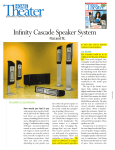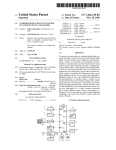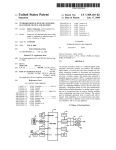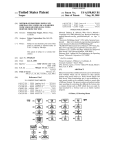Download Eiiiii |zSRUnPlxil`lY 112
Transcript
US 20120056713A1
(19) United States
(12) Patent Application Publication (10) Pub. N0.2 US 2012/0056713 A1
Stepanian
(43) Pub. Date:
Mar. 8, 2012
(54)
TETHERED DIGITAL BUTLER CONSUMER
Publication Classi?cation
ELECTRONIC REMOTE CONTROL DEVICE
(51)
AND METHOD
Inventor:
Robert
US
(
(73) Assignee:
Stepaniall,
San
Jose’
US.
)
Appl' NO"
(22)
Flled'
_
(2006.01)
. . . . . . . . . . . . . . . . . . . . . . . . . . . . . . . . . . . . . . . . . . . . . . . . . . . . . ..
ABSTRACT
Nexstep’ Inc" San Jose’ CA (Us)
The present invention relates to a tethered digital butler con
13/047’445
butler, of a price and form factor suitable for consumer elec
sumer electronics product and method. The tethered digital
_
tronics markets of developed and developing countries,
Mar‘ 14’ 2011
_
includes a communications and multi-media console and a
_
Wireless remote. The remote may resemble a handheld per
Related U‘s‘ Apphcatlon Data
(63)
Cl-
(57)
_
(21)
Int. Cl.
G05B 19/02
sonal computer (HPC), a palm-held personal computer (PPC
Continuation of application No. 12/758,241, ?led on
or PDA) or a Smart Phone, but has a low cost and feature Set
Aph 12, 2010, how pat NO_ 7,907,710, Which is a
Cohtihuatioh of application NO_ 12/572,677, ?led Oh
Oct. 2, 2009, noW Pat. NO. 7,697,669, which is a coniihuatioh of applicaiiOn NO_ 12/420,723, ?led on APL
8, 2009, how Pat' No_ 7,609,824, Which is acohtihua-
supported by the console that is novel in the consumer elec
tronics market. In particular, this disclosure relates to com
bining telephone service, device control and, Optionally, a
?ngerprint reader for easy user identi?cation/authoriZation
and personalization. As another option, a camera can be
iioh of applicaiiOn NO_ 12/210,782, ?led on Sep 15,
incorporated into the remote, thereby enabling video confer
2008, how pat NO 7,542,753, Which is a Continuation
ofapplication NO. 1 1/465,749, ?led on Aug. 18, 2006,
hOW pat NO 7,444,130’ Which is a comihuatiomihpart Of application NO_ 11/350,980, ?led Oh Feh 8,
encing and other visual features. Alternatively, the remote
may be Packaged Separately from a console and Sold to inter
2006, how pat NO_ 7,389,103
device from a different source, such as one running on a
act With capabilities of a communications and console, set
top box, multi-media PC or other consumer electronics
Windows, OS X or Linux platform, With or Without telephone
(60) Provisional application No' 60/709,666, ?led onAug_
capabilities. The remote may include a media reader and
19, 2005'
remote USB port.
(100
FINGER L21
[W A SPl/HIGH SPEED
8m]
(in
SENSOR
Flash
Hi:
GPIU P89LPC93 'I L22
KEYPAD
CONTROLLER
an
3]
PARALLEL PORT UARTU
KEYBOARD
ZEEVU‘ZV430 1 L32
I26
BLUETUUTH
[PC2132
123
TSAELK
3.6 VNI - NM
1-113‘ BATTERY
133
_)
EEHNT
GP'U
MEigPJLE
124
33v
REG J
.
BUCK/BOOST
r151
152 MIC
W160
‘4| SPEAKER |
s00
_J
Eiiiii |zSRUnPlxil’lY f 112
r141
|
93m "put DEBUG
Debug J
Header
L
153
134
H
HEAD PHUNE
Patent Application Publication
Mar. 8, 2012 Sheet 1 of6
rL00
FINGER L21
(1 11
CHIP
SENSOR
..
SPl/HIGH SPEED
PARALLEL PORT UAHTU
122
“55 GPIU P89LPC931-’
KEYPAD
PUWEHFRUM
ERADLESUPPLY (112
1-113’
8|\/lb
TRACK
BALL
GPIU
EXT'NT
LCD
GPIU
L24
Resetmput DEBUG
FIG. 1
L31
Flash
(141
(151
i 132
W
ZEEVOZVLLBUI-J H
152
BLUEBLgOTH
0 6C
LPczLsz
L23
US 2012/0056713 A1
133
HEADPHUNE
J
LL53
MODULE
Debug L34
Header
PatentApplication Publication
Mar. 8, 2012 Sheet20f 6
US 2012/0056713 A1
"""""""""""""""""""""""rnsrrnrs TCK TD TDIUr I 230
2
_ mlest/Debuglnterlaoe
m
Emulation
m [ Fz? <_ Funct'ons
System \l
-
'
21 1
| Alll/ll local Bus
v
t
5
Internal Flash
Controller
Controller
8/16/32 l<B
EINT310
lraoe
mAHBBritlge
Modu‘e
222’ l
vemred ml
253 lnterruot
A
AMBA AHB
C(Jlllllll Bl
(Advanced Hrgh-perlorrnaoe Bnsl
l
L235
I
l
AHB
(237
254- Decoder
AHBtoVPB Ivan
8/16/512 kB
External
SystemCloek
a
"(23B
Brrdge Dnrrrler
213JSl l l /l 223)FlllSH 324
l
ARMTTDMl-S
n
Internal SllAll/l
2t” l
)GLLIREJYETFM
tea‘
‘
Interrupts
“VPBWLSI
Perrpheral Bus)
_ e
I
_
PCSerral
SCUM
'
'
24a lnterlaoesllandl M.
sor<o,r
i
(Canton/Crimea?)
vlrexternaooo 525
213
l ADU.7:0
Am onverers
t 526
tlanrll2
no
227
247
E
a
i
i Aout3
PC3130
n/Aconvermrg _’
G
228
eneral
5 P1311610
I
PWMEIl
J
L
._l_J
UAHTW
g'
osnrlorsrlnrsrll
L
lleallime
Cloolr
Watchdog
llmer
_2)29
243
nrnrlonnrlrnot2 ;
nrxor
248
Purposel/O
PWMU
SPlanrlSSP
-
System
Control
Vte|
i
Patent Application Publication
Mar. 8, 2012 Sheet 3 0f 6
4.0 GB
US 2012/0056713 A1
UXFFFF FFFF
AHB Peripherals
3.75 GB
0XF000 0000
VPB Peripherals
3.5 GB
0XE000 0000
3'0 GB _
2.0 GB
Reserved Address Space
,
Boot Black (re-mapped from Orr-Chrp Flash memory)
_ M000 0000
0 8000 0000
X
Reserved Address Space
llllll as
10 GB
lGkB On-Chrp Statrc RAM lLPCZlSZ)
are Orr-Chip Static RA|\/l rreczr 31)
M000 2000
[A4000 10F
0X4000 0000
Reserved Address Space
0X0008 0000
5120;
64kR Orr-Chip
Orr-Chip Non-Volatile
Non-Volatile l\/lem0ry
Memory(LPC2132)
llPC2l38)
0.0 GB
_
.
_
.
32kB 0n Chrp Non Velatrle Memory lLPCZlSl)
FIG. 3
$8888 $299
X
UXUUUU 0000
Patent Application Publication
Mar. 8, 2012 Sheet 4 0f 6
m
IVIainPrec
LPC 2132
“L4
<
US 2012/0056713 A1
%
V KeybeardCtir ‘
7
Keyboard Matrix
P89LP931
(8 return lines x 13 scan lines)
FIG. 4
m
E
LPC 2132
AT49 BV802A
UART
EBI
Luz
ZV43U1 Blueteeth SOC
PCIVI
m
m IVIie
IVISIVI 7716
OKI codec
m Speaker
FIG. 5
Patent Application Publication
Mar. 8, 2012 Sheet 5 0f 6
US 2012/0056713 A1
.
$1
:1
it
NM5TE2QW?E
8T
1‘
52E528:5%
,5E-/i%;.
2
5
w
g
s
%
z
a
£
:
m
g
5
w
\
z
5mmEQ<w>E,E2%2UO5W|%? \f
25%:25%t:_s<%2,5bm52_1,g|w:;im- g
Q/25:03 ;
:3%:E2EAi52Nm;Q%
5,5E252M
51Q5V6521 $525
Mg
Patent Application Publication
Mar. 8, 2012 Sheet 6 0f 6
US 2012/0056713 A1
(100
INTEL XScaIe
MicroCentroIIer
L
BLUETOOTH
SPI I INTERFACE
VIDEO
CAPTURE
PORT
\L (151
I
150
3MP crrros
@ CAMERA
MODULE
USB HOST
r733
LCD INTERFACE
LCD 2.2",
320x240 TFT
752
751
W
TM
r
AUDIO CODEC
PCM/AC97
AUDIO JACK HEADSET
KEYPAD
753
OWERT
KEYPAD
INTERFACE
{-721
FINGER PRINT
SENSOR
SPIO INTERFACE
JOY
STICK
GPIO +ANALOG
INTERFACE
(724
Battery Charger 3.3 Volts
and POWOI
1 ZVOItS
Management
(712
Battery Pack
'
Media
Reader
m
Adapter
Mar. 8, 2012
US 2012/0056713 A1
[0005]
For developing countries and cost-conscious buy
TETHERED DIGITAL BUTLER CONSUMER
ELECTRONIC REMOTE CONTROL DEVICE
AND METHOD
too expensive. An opportunity arises to provide a loW-cost
RELATED APPLICATIONS
integrated consumer electronics system that includes a novel
feature set and a cost-effective allocation of technical tasks
ers, the Treo and media center approaches are over-built and
betWeen a remote and a console.
[0001] This application is a continuation of US. Pat. No.
7,907,710, to be issued Mar. 15, 2011 from application Ser.
No. 12/758,241, ?led 12Apr. 2010, by inventor Robert Stepa
nian, entitled, “TETHERED DIGITAL BUTLER CON
SUMER ELECTRONIC DEVICE AND METHOD”, Which
SUMMARY OF THE INVENTION
[0006] The present invention relates to a tethered digital
butler consumer electronics product and method. The teth
is a continuation ofU.S. Pat. No. 7,697,669, ?led 2 Oct. 2009,
Which is a continuation of US. Pat. No. 7,609,824, ?led 8
ered digital butler, of a price and form factor suitable for
consumer electronics markets of developed and developing
Apr. 2009, Which is a continuation ofU.S. Pat. No. 7,542,753,
?led 15 Sep. 2008, Which is in turn a continuation of US. Pat.
No. 7,444,130, ?led 18 Aug. 2006, Which is a continuation
countries, includes a communications and multi-media con
sole and a Wireless remote. The remote may resemble a hand
in-part ofU.S. Pat. No. 7,389,103, ?led Feb. 8, 2006, Which
claims the bene?t of US. Provisional Application No.
60/709,666, ?led 19 Aug. 19, 2005.
[0002] This application is related to US Design Patent
Application Nos. 29/236,023, 29/236,022 and 29/236,022,
?led onAug. 10, 2005 by inventors Phoebe Ng, Robert Stepa
nian and Allison S. Conner, entitled, “NAVIGATION BUT
TON ARRAY FOR REMOTE CONTROL HOUSING”,
“REMOTE CONTROL HOUSING” and “CONSOLE
HOUSING”. The priority, provisional and related design
applications are incorporated by reference.
held personal computer (HPC), a palm-held personal com
puter (PPC or PDA) or a smart phone, but has a loW cost and
feature set supported by the console that is novel in the con
sumer electronics market. In particular, this disclosure relates
to combining telephone service, device control and, option
ally, a ?ngerprint reader for easy user identi?cation/authori
Zation and personalization. As another option, a camera can
be incorporated into the remote, thereby enabling video con
ferencing and other visual features. Alternatively, the remote
may be packaged separately from a console and sold to inter
act With capabilities of a communications and console, set
top box, multi-media PC or other consumer electronics
device from a different source, such as one running on a
BACKGROUND OF THE INVENTION
[0003] The present invention relates to a tethered digital
butler consumer electronics product and method. The teth
WindoWs, OS X or Linux platform, With or Without telephone
capabilities. The remote may include a media reader and
remote USB port. Particular aspects of the present invention
are described in the claims, speci?cation and draWings.
ered digital butler, of a price and form factor suitable for
consumer electronics markets of developed and developing
countries, includes a communications and multi-media con
sole and a Wireless remote. The remote may resemble a hand
held personal computer (HPC), a palm-held personal com
puter (PPC or PDA) or a smart phone, but has a loW cost and
feature set supported by the console that is novel in the con
sumer electronics market. In particular, this disclosure relates
to combining telephone service, device control and, option
ally, a ?ngerprint reader for easy user identi?cation/authori
Zation and personalization. The remote may be packaged
separately from a console and sold to interact With capabili
ties of a communications and multi-media console from a
different source, such as one running on a WindoWs, OS X or
Linux platform.
[0004] Convergence of digital devices is not unbounded,
BRIEF DESCRIPTION OF THE DRAWINGS
[0007]
FIG. 1 is a block diagram of the digital butler
remote.
[0008] Details of the main processor are depicted in FIG. 2.
[0009] The LPC 2132 memory maps are shoWn in FIG. 3.
[0010] FIG. 4 shoWs the 8051 based Philips LPC89LPC931
controller.
[0011] FIG. 5 shoWs the ZV4301 to other CPU and periph
eral interfaces.
[0012] FIG. 6 is a block diagram ofthe console.
[0013] FIG. 7 is an alternative block diagram of the digital
butler remote, With a CMOS camera module and/ or memory
card reader.
DETAILED DESCRIPTION
because it is guided by market realities. Many concepts are
?oated as trial balloons that burst, never to see an enabling
development effort or a reduction to practice. Some conver
gence trends are strong and noteWor‘thy. Cellular smartphones
or business phones such as Treo or Blackberry products are
[0014]
The folloWing detailed description is made With ref
erence to the ?gures. Preferred embodiments are described to
illustrate the present invention, not to limit its scope, Which is
de?ned by the claims. Those of ordinary skill in the art Will
becoming poWerful and supplanting separate PDAs. These
recogniZe a variety of equivalent variations on the description
smartphones go With the user across a cellular netWork and
that folloWs.
even overseas. They are untethered, packing many features
into a small form factor, not requiring a console. Another
trend is to repackage a PC as media center, complete With a
held remote With a novel combination of features that are
Wireless keyboard. Recent announcements suggest interfac
ing a Microsoft media center With a Bluetooth-equipped cel
lular telephone to use the sound reproduction of a TV as a sort
of speaker phone, relying on the cellular telephone for net
Work connectivity. In both instances, the telephone features
are untethered from and do not depend on availability of a
console.
[0015]
A tethered digital butler produces a loW cost, palm
implemented by logic and resources of the console, con
nected Wirelessly to the palm-held remote. Tethering the
palm-held device, so that it depends on logic and resources of
the console, runs against the trends and teachings of the
consumer electronics industry and particularly against the
trend toWard more poWerful smartphones.
[0016] Various novel combinations of features are empha
siZed in this application. One Will recogniZe that the features
US 2012/0056713 A1
discussed can be combined in many Ways, While remaining
faithful to the tethered digital butler concept.
[0017] In a ?rst embodiment of the tethered digital butler,
Mar. 8, 2012
voice messaging, listening to music or remote vieWing video.
To support the high demands of streaming video, a broader
personalize the user’s telephone, TV vieWing, media access
communications channel, such as Bluetooth version 2 or later
or 802.1 In, and a more poWerful processor are included. The
remote may function in tandem With a console, PC or set top
cable or satellite box. It also could be con?gured to control
other consumer electronics device such as a TV, IP-TV, home
and internet broWsing experiences, to connect the user to a
theater system, component stereo, digital video recorder,
telephone netWork consistent With the user’s authentication,
DVD player or recorder, VCR, etc. It can receive streaming
media directly from a server. The palm-held remote may be
the palm-held remote alloWs a user to select among and use
logic and resources of a bread-box or smaller siZed console to
authenticate users from a ?ngerprint reader on the remote, to
and to control multi-media features, such as channel control,
volume control, DVD/CD playback control, and digitally
combined With a glue logic application that enables a console,
stored music access and playback. In this embodiment, the
palm-held remote integrates at least a ?ngerprint reader, a
speaker, microphone and volume control adapted for use as a
PC, set top box or other consumer electronics device to utiliZe
telephone, a display at least capable of shoWing a telephone
number, a cursor control and trigger adapted to select and
control resources of the console, a compact keypad including
numeric keys usable for telephone dialing, the compact key
pad further including alphabetic keys usable for Web broWs
ing. The bread-box or smaller siZed console integrates at least
a DVD/CD player, a netWork port and logic and resources
adapted to authenticate users of the palm-held remote and
the special purpose controls of the remote. The remote may be
adapted to invoke a glue logic application supplied for or
native to a communications and/ or multi-media console, such
as one running under WindoWs, OS X or Linux.
[0022] In a sixth embodiment, a remote control for a gate
Way device t is coupled to multimedia and communication
resources. The gateWay device including logic and resources
to process Wireless input and provide access to the multime
dia and communication resources. The remote control
personaliZe their telephone netWork connection and their
includes a palm-held remote adapted to invoke glue logic
running on the gateWay device by Wirelessly directing input to
Internet broWsing based on ?ngerprints received from the
the gateWay device. It integrates at least a speaker and volume
palm-held remote, connect telephone features of the palm
control adapted for use as a remote speaker, a ?ngerprint
reader and a cursor control and trigger adapted to select and
control resources of the console. Glue logic invoked Wire
held remote to the telephone netWork, respond to Internet
broWsing commands from the palm-held remote and display
Web pages on a monitor or television, control channels
lessly by the remote control is adapted to connect the speaker
accessed by a video receiver, drive speakers and provide
volume control, provide playback control for the DVD/CD
player, and access and playback digitally stored music.
to a sound reproduction module and connect the ?ngerprint
reader to an authentication and personaliZation module that
selects a user pro?le based on activation of the ?ngerprint
reader and authentication of the user. The personaliZation
[0018] In a second embodiment of the tethered digital but
ler, the palm-held remote has feWer components; the console
supports feWer features; thus, the combination Will be less
expensive and more attractive in many markets. Remote com
ponents then include a speaker, microphone and volume con
trol adapted for use as a telephone, a display at least capable
of shoWing a telephone number, a cursor control and trigger
adapted to select and control resources of the console, and a
compact keypad including numeric keys usable for telephone
module adapted to present the user’s personaliZed favorite
media access, present the user’s personaliZed history lists,
automatically authenticate the user for digital rights manage
ment, automatically authenticate the user for communication
access, and automatically authenticate the user for electronic
Wallet reproduction of purchasing credentials.
[0023] An alternative to video operation of a camera is still
operation of the camera. The still camera may be Wirelessly
coupled to a photographic capture module running on another
dialing. The ?ngerprint reader is not included, nor is the
alphabetic keypad. The logic and resources of the console are
reduced accordingly. Logic and resources of the console need
the other device can simplify the remote and reduce its co st, as
not authenticate and personaliZe based on ?ngerprints or
only temporary buffering in the remote is needed.
access and playback digitally stored music. Internet broWsing
may be limited or may be supported by an on-screen key
board.
[0019] In a third embodiment of the tethered digital butler,
the DVD/CD player is omitted from the console. The features
of the palm-held remote do not much change, but the logic
device, Which persists the pictures taken. The persistence at
[0024] An aspect of this disclosure that can be combined
With any of the foregoing embodiments is remote on-screen
menu and controls display, translating a device menu and
controls display that Would normally appear on a TV or
monitor for reproduction on a display that is part of the
remote. To implement this capability, a menu-generating
and resources required of the console are reduced.
device can assemble on-screen menus and controls as sepa
[0020]
rate data stream, apart from any video image that the menus
and controls overlay. The data stream can be supplied both to
In fourth embodiment, the console is implemented
on a PC, Which may be larger than bread-box siZed. This
typically Would be less desirable, as most PCs do not ?t a
media room decor and are relatively loud, due to fans and hard
disk rotation. A neW generation of PCs, such as the Mac Mini,
presents a small form factor (presently 6.5><6.5><2 inches) and
quiet operation, While including enough computing poWer to
the device’s oWn on-screen overlay generator and to a com
munications module coupled to the remote. The remote uses
the data stream to render the on-screen display in a legible
format, adapted to the reduced siZe of a screen on the remote.
Preferably, the menu and control organiZation format on the
function as PC.
remote mimics What the vieWer can see on the screen, to
[0021] In a ?fth embodiment, the remote is emphasiZed.
One aspect of the remote is to provide a complete I/O plat
form in the palm of the user’s hand. Features adaptable to
VoIP and/or video phone operation, such as a microphone,
minimiZe confusion. Technologies such as a subset of HTML
and JavaScript alloW a designer to specify a menu and control
can be used for other purposes, such as dictation, note taking,
layout in terms that permit rendering to a variety of display
siZes. Remote display of the on-screen menu and control data
stream may preempt a video image display or may be overlaid
Mar. 8, 2012
US 2012/0056713 Al
on top of the video image. Optionally, the device’s on-screen
menu and controls can be supplied to the remote exclusively
the user sWipes the ?ngerprint sensor, then personaliZation
can be applied, analogous to sWitching users in current Win
as a data stream and not as part of a rendered video stream, to
doWs XP implementations. This degree of context shifting
avoid confusing menus of different siZes. Alternatively, the
based on a single action at a remote control is believed to be
on-screen menus and controls may just appear on the
remote’s display as a consequence of being rendered to a TV
neW and unique. The personaliZation may include: favorite
channels/movies/shoWs in a streaming video environment;
or monitor that is reproduced on the remote’s display.
favorite music, photos or video in an on demand environment;
In any of these embodiments, a camera module can
approved access to DRM-controlled content using one or
be incorporated into the remote, thereby enabling video con
ferencing and other visual features. The camera is comple
mented by a glue logic application supplied for or native to a
more keys linked to the ?ngerprint; history of searches, recent
topics, personal interest (a la Google Sidebar or Claria Per
communications and/ or multi-media console, such as one
recently accessed ?les; automatic authenticated access to
communication channels linked to the ?ngerprint, such as
[0025]
running under WindoWs, OS X or Linux. To support full
sonalWeb), personal receptiveness to advertising content,
ernet protocol may be used to supply the required bandWidth.
voice over IP, instant messaging, Web conferencing and
e-mail; electronic Wallet access, automatically looking up
[0026] As a further aspect of these embodiments, the con
sole may be equipped With a non-volatile memory siZed to
mation; and sharing of information by person logged in.
motion video, Bluetooth version 2 or later or a Wireless Eth
credit card information and other account authoriZation infor
time-shift playback from the video receiver and its logic and
[0031]
resources are further adapted to provide a menu of upcoming
control button that causes the remote to emit a tone Which
video content, schedule recording of the video content and
replay the video content. Alternatively, the non-volatile
makes it easier to locate.
[0032] The form factor of a palm-held remote should be
memory may be siZed to hold a library of digital music.
[0027]
The U0 platform in the palm of our hand concept
can be enhanced by adding a memory card reader to the
remote. One or more of the many memory card formats noW
in use or as may be developed in the future can be accommo
dated.
[0028] Another form of U0 is provided through a USB or
FireWire port. The remote may integrate a USB connector and
port or similar FireWire support. Glue logic running on the
host device may be adapted to treat the USB or FireWire port
as if it Were local to a machine being accessed using the
The console may be equipped With a remote locator
easily recognized.
[0033] The form factor of a bread-box or smaller siZed
console can be judged by volume. A smallish consumer elec
tronics component uses an enclosure (from Which connectors
and feet protrude) that is 12 by 15 by 3 inches and has a
volume of 540 cubic inches. This is an approximately bread
box siZed enclosure, although the shape differs from a loaf of
bread.
Remote HardWare
remote.
[0034]
[0029] In another aspect of these embodiments, the remote
may hold a DRM key and automatically deliver the key to
[0035] The digital butler remote is a gadget based on the
Bluetooth or another Wireless technology used for communi
cations and remote control applications.
DRM-enabled device. Either memory on the remote, a
memory module or an identi?cation reader combined With
the remote may hold the DRM key. The identi?cation reader
can read a smart card or similar module With memory or can
read a ?ngerprint in order to authoriZe automatic use of the
DRM key to exercise DRM-evidenced rights. When a user
visits a neighbor’s console, they may take along their hand
held remote and the associated digital rights for use on the
neighbor’s console or other device.
[0030] Another feature that can be combined With any of
these embodiments is personaliZation based on a single
action, a sWipe of the ?ngerprint reader. Coupled Wirelessly
to the ?ngerprint sensor softWare is a personaliZation module.
Introduction
[0036]
Features
[0037]
The digital butler remote board is an ARM7 proces
sor based solution.
[0038] This remote is built around the Philips LPC2l32
ARM controller. The main processor provides interfaces for
the Keypad, Trackball or other pointing device, 128*32
graphics LCD module, ?ngerprint sensor, and Bluetooth
SOC. The Bluetooth SOC and Zeevo ZV4301 interface With
a microphone, speaker and headphone for voice utilities. The
system may use a Philips 89LPC931 controller for the keypad
interface through a 12C Bus. Alternative hardWare con?gu
If a user does not identify himself by sWiping the ?ngerprint
sensor, then a generic pro?le is applied to personaliZation of
rations are illustrated in FIGS. 7 and 8.
music, movies, photos, videos, ?les and telephone access. If
remote.
[0039]
FIG. 1 is a block diagram of the digital butler
Embodiment Details
Chip Name
Chip number
Description
Main processor
LPC2132, Philips.
Main CPU, 60 MHZ/64 Kb ?ash/l6 Kb
89LPC931, Philips.
8051 MCU compatible With 8 KB ?ash,
DDGl2803 ZAAD, DDTL.
128*32 graphics parallel/serial LCD
(100)
Keypad controller
SRAM
12C interface.
(122)
LCD Display module
(133)
Module.
US 2012/0056713 A1
Mar. 8, 2012
4
-continued
Embodiment Details
Chip Name
TrackBall (123)
Chip number
Description
TBWBZAOO, ITT
Miniature all directional scanning switch.
Industries, Cannon;
Omni- or Vari-Point or
Omni- or Vari-Disk
devices, ITT Industries,
Cannon.
Fingertip sensor (121)
Bluetooth SOC (132))
AES3400, Authentech.
ZV4301, Zeevo or
equivalent by Broadcom or
Fingertip sensor with SPI interfaces.
Bluetooth SOC With, UART interface.
Flash Memory (131)
Codec IC (141)
AT49BV802A, Atmel.
MSM7716, OKI.
Bluetooth SOC Flash, 8 Mb
Single rail codec.
Power Supply (113)
LTC 3440EDD — Linear
Micro power synchronous 600 ma Buck
Technology.
Boost Dc-DC converter
RSMD.
[0040] Additional details of the main processor are
depicted in FIG. 2. The LPC2132 (100) is based on a 32/16bit ARM7TDM1-S CPU (232) with real time emulation and
embedded trace support, together with 64 Kbytes (KB) of
embedded high speed ?ash memory (223). A 128 bit wide
memory interface (211, 212, 222) and accelerator architecture enable 32 bit code execution at maximum clock rate. For
[0046] Real-time clock (247) equipped with indepen
dent power and clock supply permitting extremely low
POWer Consumption in POWer-SaVe IIlOdeS~ Multiple
serial interfaces including two UART (16C550) (246),
1W0 Fast IZC-bUS (400 Kb/S) (244), SP1 and SSP (245)
With buffering and Variable data length Capabilities.
[0047] Vectored interrupt controller (253) with con?g
critical code siZe applications, an alternate 16 bit “thumb
mode” reduces code by more then 30% with minimal perfor-
urable priorities and vector addresses.
[0048] Up to 47 5 V tolerant general purpose I/O pins
mance penalty. Due to their tiny size and low power consumption, these micro controllers are typically used for miniatur-
iZed applications, such as hand-held equipment. Most
(228) in tiny LQFP64 package,
[0049]
Up to nine edge or level Sensitive external inter
rupt pins (224) available_
peripheral pins can also be remapped as General Purpose I/0
[0050]
pins. The system includes on-chip SRAM of 1 6 KB (213) and
is well suited for communication gateways and protocol con-
programmable Omchip pLL (241)_
[0051] Omchip Crystal Oscillatorwith an Operating range
verters, soft modems, vo1ce recogn1t1on and low end manag-
ing, providing both large buffer siZe and high processing
power. Various 32-bit timers (247, 248), 10-bit 8 channel
ADC(s) (226), 10-bit DAC (227), PWM channels (225) and
47 GPIO lines (228) with up to nine edge or level sensitive
external interrupt pins, make these microcontrollers particu
larly suitable for industrial control and hand-held systems.
[0041] The integrated ARM microprocessor operates at 60
MHZ and, in one embodiment, supports the following fea
tures:
[0042] 16/32-bit ARM7TDM1-S microcontroller (232)
in a tiny LQFP64 package. 8/16/32 KB of on-chip static
.
RAM (213) and 64/512 KB of on-ch1p Flash program
60 MHZ maximum CPU Clock available from
of 1 MHZ to 30 MHZ
[0052]
Power saving modes include idle and Power
down.
[0053]
Individual enable/disable of peripheral functions
as well as peripheral clock scaling down for additional
power optimization.
[0054]
Processor wake-up from Power-down mode via
external interrupt (224).
[0055]
Single power supply chip with POR and BOD
circuits.
[0056]
CPU operating voltage range of 3.0V to 36 V (33
V:10%) with 5 V tolerant I/ O pads.
,
memory (223). A 128 bit wide interface/accelerator
[0057]
(211, 212, 222) enables high Speed 60 MHZ Operation‘
be used for both code and data 'storage. Programming of the
/
1.
.
_
/
[0%4A3I] .lmsysgimblmAlpp 56mm? progsrmllmglé IEISP
tor 395310
The LPC 2132 S 64 KB of ?ash memory (2230111213,
?ash memory may be accomphshed in several ways. It may
be programmed in the system via the serial port (245). The
21215060; zgoiilssoaltllgirrzgrgll?liingsofzescé
application program may also erase and/ or program the ?ash
bytes in 1 Ms. Embedded Trace interfaces (231) offer
1 _
d b
_
_ h h
h,
1
_
ft
rea ‘nme e uggmg Wlt t 6 011-0 1p rea momtor SO '
'
'
'
? ~b'l't f d t
W h'l
16 th e app l'10a t'Ion 1S
runmng’
a ll OWmg
em 1 1y or a a
storage ?eld ?rm grade upgrades, etc. While the on chip boot
loader is used, 64 KB ?ash memory is available for user code.
Ware and high Speed tracing of instruction execmion'
One 8 Channel lo'blt D convéners (226), PYOYIdeS a
The LPC2132 ?ash memory provides a minimum of 100,000
erase/write cycles and 20 years of data retention. On-chip
total Ofup to 16 analog Inputs’ Wlth Converslon tunes as
static RAM (213) may be used for code and/or data storage.
low as 244 P's per Channel‘
The SRAM may be accessed as 8 bits, 16 bits or 32 bits wide.
[0044]
Single lo'bit D/A converter (227) Pm‘ddes Vari'
able analog Output
[0045] Two 32-bit timers/counters (with four capture
and four compare channels each) (225), PWM unit (six
outputs) (225) and watchdog (248).
General purpose parallel I/ O is supported by device pins that
are connected to a speci?c peripheral function are controlled
by the GPIO registers. Pins may be dynamically con?gured as
inputs or outputs. Separate registers allow setting or clearing
any number of outputs simultaneously. The value of the out
Mar. 8, 2012
US 2012/0056713 A1
put register may be read back, as Well as the current state of
the port pins. The GPIO lines have the following features.
[0058] Direction control of individual bits.
[0059] Separate control of output set and clear.
[0060] All I/ O default to inputs after reset.
[0061]
The LPC 2132 memory maps shoWn in FIG. 3 incor
[0074]
[0075]
Standard I2C compliant bus interface.
Easy to con?gure as master, slave, or line-select
master or slave.
[0076]
[0077]
Programming clocks alloW versatile rate control.
Bi-directional data transfer betWeen masters and
slaves.
porate several distinct regions. In addition, the CPU interrupt
[0078]
vectors may be re-mapped to alloW them to reside in either
[0079] Arbitration betWeen simultaneously transmitting
Flash memory (by default) or on-chip static RAM.
[0062] The vectored interrupt controller (VIC) accepts all
of the interrupt request inputs and categorizes them as FIQ,
vectored IRQ, and non vectored IRQ as de?ned by program
mable setting. The programmable assignment scheme means
that priorities of interrupts from the various peripherals can be
dynamically assigned and adjusted.
[0063] Fast interrupt request (FIQ) has the highest priority.
If more than one request is assigned to FIQ, the VIC combines
the requests to produce the FIQ signal to the ARM processor.
The fastest possible FIQ latency is achieved When only one
request is classi?ed as FIQ, because then the FIQ service
routine can simply start dealing With that device. But if more
than one request is assigned to the FIQ class, the FIQ services
routine can read a Word from the VIC that identi?es an FIQ
source that is requesting an interrupt. Vectored IRAs have
middle priority. Sixteen of the interrupts can be assigned to
this category. Any of the interrupt requests can be assigned to
any of the 16 vectored IRQ slots, among Which slot 0 has the
highest priority and slot 15 has the loWest. Non-vectored
IRQ’s have the loWest priority.
[0064] The VIC combines the requests from all the vec
tored and non-vectored IRAs to produce the IRQ signal to the
ARM processor. The IRQ service routine can start by reading
the register from the VIC and jumping there. If any of the
vectored IRAs are requested, the VIC provides the address of
the highest-priority requesting IRAs service routine, other
Wise it provides the address of a default routine that is shared
by all the non vectored IRAs. The default routine can read
another VIC register to see What IRAs are active.
[0065] The LPC 2132 contains tWo UARTs (246). One
UART provides a full modem control handshake interface,
the other provides only transmit and receive data lines. The
features of UART is listed beloW:
[0066] 16 byte, receive and transmit FIFO s.
[0067] Register locations conform to ‘550’ industry stan
dard.
[0068]
Receiver, FIFO trigger points at 1, 4, 8, and 14
bytes.
[0069]
[0070]
Built in baud rate generator.
Standard modem interface signals included on
UART 1.
[0071] I2C (244) is a bi-directional bus for inter IC control
using only tWo Wires, a serial clock line (SCL) and a serial
data line (SDA). Each device is recognized by a unique
address and can operate as either a receiver only device or a
transmitter With the capability both to receive and send infor
mation.
[0072] Transmitters and/or receivers can operate in either
master or slave mode, depending on Whether the chip has to
initiate a data transfer or is only addressed. I2C is a multi
master bus that can be controlled by more than one bus master
connected to it.
[0073] I2C implemented in LPC2132 support bit rate up to
400 kbit/s (Fast I2C). The features of LPC2132 I2C bus is
listed beloW:
Multi master bus (no center master)
masters Without corruption of serial data on the bus.
[0080]
Serial clock synchronization alloWs devices With
different bit rates to communicate via one serial bus.
[0081] Serial clock synchronization can be used as a
hand shack mechanism to suspend and resume serial
transfer.
[0082] The I2C bus may be used for test diagnostics
purposes.
[0083] The SPI (245) is a full duplex serial I/O interface,
designed to be able to handle multiple masters and slaves
connected to a given bus. A single master and a single slave
communicate on the interface during a given data transfer.
During a data transfer, the master alWays sends a byte of data
to the slave, and the slave alWays sends a byte of data to the
master. The features of the SPI controller is listed beloW:
[0084] Compliant With serial peripheral interface (SPI)
speci?cation.
[0085] Synchronous, serial, full duplex, communication.
[0086] Combined SPI master and slave.
[0087] Maximum data bit rate of one eighth of the input
clock rate.
[0088]
The real time clock (RTC) (247) is designed to pro
vide a set of counters to measure time When normal or ideal
operating mode is selected. The RTC uses little poWer, mak
ing it suitable for battery poWered systems Where the CPU is
not running continuously (idle mode). The features of RTC
are described beloW.
[0089] Measures the passage of time to maintain a cal
endar and clock.
[0090] Ultra loW poWer design to support battery poW
ered systems.
[0091] Provides seconds, minutes, hours, day, month,
year, day of Week, and the day of year.
[0092] Programmable reference clock divider alloWs
adjustment of the RTC to match various crystal frequen
cies.
[0093] The 8051 based Philips LPC89LPC931 controller
in FIG. 4 is suitable for keyboard interface. The P89LPC930/
931 (404) is based on a high performance processor architec
ture that executes instructions in tWo to four clocks, six times
the rate of standard 80C51 devices. Many system-level func
tions have been incorporated into the P89LPC930/931 in
order to reduce component count, board space, and system
cost. The P89LPC931 has the folloWing enhanced features:
[0094] A high performance ARM processor 80C51 CPU
provides instruction cycle times of 111 ns to 222 ns for
instructions except multiply and divide, When executing
at 18 MHz. This is six times the performance of the
standard 80C51 running at the same clock frequency. A
loWer clock frequency for the same performance results
in poWer savings and reduced EMI.
[0095] 2.4 V to 3.6 VVDD operating range. I/O pins are
5 V tolerant.
[0096] 8 kB ?ash code memory With 1 kB sectors, and
64-byte page size.
Mar. 8, 2012
US 2012/0056713 A1
[0097]
data
[0098]
[0099]
Byte-erase allowing code memory to be used for
storage.
Flash program operation completes in 2 ms.
256-byte RAM data memory.
[0100]
Real-time clock that can also be used as a system
[0109]
The following tables describe interfaces among the
CPU (100), keyboard controller (404) and matrix (406):
timer.
[0101] Enhanced UART With fractional baud rate gen
Keyboard Controller to CPU Interface
erator, break detect, framing error detection, automatic
address detection and versatile interrupt capabilities.
[0102]
port
[0103]
Signal
LPC2132
P89LPC93
R?m?rks
Serial I2C Data
SDA
SDA
I2C interface
Serial 12C Clock
SCL
SCL
12C int?rf?w
400 kHZ byte-Wide 12C-bus communication
Eight keypad interrupt inputs, plus tWo additional
external interrupt inputs.
[0104] Four interrupt priority levels.
Keyboard Controller to Matrix Interface
P89LPC93
[0105]
Signal
Signal Name key board
Remarks
K131.0 Keybd input 1
KBI.1 Keybd input 2
K13I.2 Keybd input 3
K13I.3 Keybd input 4
KBIA Keybd input 5
K13I.5 Keybd input 6
K13I.6 Keybd input 7
K13I.7 Keybd input 8
K130.0 Keybd output 1
K130.1 Keybd output 2
K130.2 Keybd output 3
K130.3 Keybd output 4
KBOA Keybd output 5
K130.5 Keybd output 6
K130.6 Keybd output 7
K130.7 Keybd output 8
K130.8 Keybd output 9
K130.9 Keybd output 10
K130.10 Keybd output 11
K130.11 Keybd output 12
K130.12 Keybd output 13
P0.0
P0.1
P0.2
P0.3
P0.4
P0.5
P0.6
P0.7
P2.0
P2.1
P2.2
P2.3
P2.4
P2.5
P2.6
P2.7
P1.0
P1.1
P1.4
P1.6
P1.7
Keybd
Keybd
Keybd
Keybd
Keybd
Keybd
Keybd
Keybd
Keybd
Keybd
Keybd
Keybd
Keybd
Keybd
Keybd
Keybd
Keybd
Keybd
Keybd
Keybd
Keybd
On-chip poWer-on reset alloWs operation Without
[0110]
RET LINE 1
RET LINE 2
RET LINE 3
RET LINE 4
RET LINE 5
RET LINE 6
RET LINE 7
RET LINE 8
SCAN LINE
SCAN LINE
SCAN LINE
SCAN LINE
SCAN LINE
SCAN LINE
SCAN LINE
SCAN LINE
SCAN LINE
SCAN LINE
SCAN LINE
SCAN LINE
SCAN LINE
1
2
3
4
5
6
7
8
9
10
11
12
13
Return line 1
Return line 2
Return line 3
Return line 4
Return line 5
Return line 6
Return line 7
Return line 8
Scan line 1
Scan line 2
Scan line 3
Scan line 4
Scan line 5
Scan line 6
Scan line 7
Scan line 8
Scan line 9
Scan line 10
Scan line 11
Scan line 12
Scan line 13
The LCD display (133) DD12803AAD, in one
external reset components. A reset counter and reset glitch
embodiment, is a 128*32 dot matrix LCD module. The LCD
suppression circuitry prevent spurious and incomplete resets.
Module can be easily accessed via parallel micro controller
GPIO interface. Its features include:
A softWare reset function is also available.
[0106] The keypad 8*13 matrix (406) is connected to the
GPIO lines of P89LPC931 micro controller (404). The key
[0111] Trans?ective display mode and positive type,
pad has 8 return lines and 13 scan lines. The return lines are
[0112] Graphic 128*32 dot-matrix display format.
connected to the keyboard port of the P89LPC931 micro
[0113]
Parallel input data from micro controller.
controller. The P89LPC931 is connected to the main proces
sor LPC2132 through the 12C bus to minimize the number of
pins on the main processor.
[0107] The custom softWare is loaded into the ?ash pro
gram memory of the P89LPC931 micro controller Which
scans the keypad and generates ASCII codes and communi
cates to the main processor through the 12C bus. The
P89LPC931 micro controller is normally kept in poWer save
[0114]
1/ 33 duty multiplexing ratio.
[0115]
[0116]
1/16 bias.
6 o’clock vieWing direction.
mode, and it Will aWaken in response to keyboard interrupts
after the key press. The keyboard port of P89LPC931 has a
change on status interrupt feature, and hence any key press
Will generate the keyboard interrupt. The key bounces are
taken care of by the softWare.
[0108] The QWERTY keyboard may have a Chinese char
acter entry feature and the softWare transfers the Chinese
corresponding ASCII codes to the main processor in Chinese
key entry mode.
B/W mode, FSTN LCD.
[0117] Dimension outline 35 (W)*28.9 (H)*1.75 (D)
mm.
[0118] Resolution 128*32 dots.
[0119] Active area 29.66 (W)*8.45 (W) mm.
[0120] Dots pitch 0.232 (W)*0.265 (H) mm.
[0121] Dots siZe 0.202 (W)*0.235 (H) mm.
[0122] The ITT Industries, Cannon TBWB2A00 trackball
(123) is a miniature all directional scanning sWitch developed
for mobile, remote, PDA, notebook PC, and hand-held device
applications. It includes tWo perpendicular rollers actuated by
friction on the ball and tWo spring contacts Which generate
(by contact closing and opening) the electrical pulses and a
light tactile effect (click) at each pulse. A sWitch called
“Select” is integrated in the trackball. Optimally, tWo LEDs
Mar. 8, 2012
US 2012/0056713 A1
can be included With the trackball and driven according to the
[0135]
Wishes of the user. Several tactile effects can be obtained
clock input
[0136] USB selective suspend support
[0137] Ultra-hard surface coating
according to the number of tooth integrated in the gear axle;
the standard resolution is 12 pulses perball rotation. When the
Trackball is activated, its relative position changes are ana
lyZed in tWo directions X andY. The tWo perpendicular rollers
are actuated by friction on the ball. During their revolution,
the rollers activate tWo spring contacts Which generate (by
contact closing and opening) the electrical pulses.
[0123] To track the ball movements, a simple electronic
device tied to the direction contacts converts the vertical and
horizontal displacements of the both perpendicular rollers in
logical levels of X-axis andY-axis displacements: Some pull
up resistors (or respectively pull doWn resistors) are tied to the
axis direction contacts While the common contact is tied to the
ground (or respectively to the poWer supply potential). The
change in state interrupts the main LPC2132 processor (100).
The output pulse frequency is directly proportional to the
moving speed and the direction. The pulse frequency is pro
cessed by the main processor LPC2132 and the correspond
ing PS2 data sent to the host system.
[0124] Alternatively, the ITT Industries, Cannon Omni- or
6 or 12 MHZ operation With crystal or supplied
[0138]
[0139]
[0140]
[0141]
1 million rubs W/o degradation
Highly scratch resistant
IEC 61000-4-2 level 3 ESD capability (+/—8 KV)
Built-in loW poWer ?nger detection W/ system
interrupt capability
[0142] LoW poWer operation; <6 mW/imaging event.
[0143] The interface of these ?ngertip sensors is pin
selectable choices. The SPl interface ?nger chip sensor
is selected so that the ?nger tip sensor is connected to the
SP1 port (245) of the main processor.
[0144] The Zeevo ZV4301 in FIG. 5 used in one embodi
ment is a Bluetooth SOC adapted to provide a high bandWidth
CPU system to add Wireless connectivity to their product. The
ZV 4301 (502) incorporates the industry standard 32 bit
ARM7TDM1 CPU core With high bandWidth processing
capability su?icient to support a Wide range of embedded
applications. The ZV4301 operates from —25 C to 85 C and
Vari-Point joystick or the Omni- or Vari-Disk navigation disk
comes in a lead free version. The ZV4301 is implemented in
a 0.18 micro meter CMOS process and includes the integra
can be used instead of a trackball.
tion of all RF components and digital circuitry. The only
[0125] The AuthenTec EntrePad, AES3400, AuthenTec’s
3rd generation loW poWer, small form-factor ?ngerprint iden
external components needed are an antenna, crystal, refer
ti?cation sensor IC (121). This product combines silicon
based image capture With a proprietary sensor control and
matching algorithms to deliver ability-to-acquire (ATA) ?n
gerprint images and authentication. AuthenTec’s EntrePad
AES3400 utiliZes TruePrint Technology, alloWing the sensor
to look past the easily obscured outer surface of the skin to the
living layer beloW Where the unique ridge and valley patterns
of the ?ngerprint originate. Trueprint is AuthenTec’s unique
patented imaging technology. During imaging, a small near
?eld signal is generated betWeen the IC and the ?nger’s living
tissue layer. 16,384 individual elements in the sensor matrix
form a planar antenna array that receives this signal, creating
a digital pattern that accurately reproduces the ?ngerprint’s
underlying structure. A poWerful utility Within TruePrint is
Dynamic Optimization. This tool analyZes each image, con
trolling up to 15 sensor parameters to optimiZe the ?ngerprint
image, regardless of unusual skin conditions or surface con
tamination. The TruePrint high-quality ?ngerprint imaging
technology enables reliable authentication.
[0126] The ?ngerprint sensor is small, battery friendly and
Well-suited to Bluetooth communications. These sensors
automatically generate interrupts and reduce system over
head needed for ?nger detection.
[0127] Features of the ?ngerprint component, in one
embodiment, include:
[0128] TruePrint technology for ability to acquire (ATA)
[0129] Compact industry standard 100-Pin LQFP Pack
age
[0130] High de?nition 128x128 TruePrint technology
based pixel array
[0131] 500 pixels per inch (ppi)
[0132]
sleep and deep sleep modes, and operates from a single 3.3V
supply. The ZV4301 is manufactured in an 8.6><8.6><1.65 mm
LTCC BGA package With 100 balls.
[0145] The ZV4301 is supplied With a link library for a
complete loWer layer protocol stack and source code to the
blueOS operating system, target manager and link manager
APl. Upper layers are supported through the Zeevo partner
program With ?rmWare, Bluetooth protocol stack softWare
and Bluetooth pro?les available from Zeevo’s extensive part
ner list.
[0146] The Zeevo4301 typical application supports AV
equipment, smart phones, personal digital assistants, printers,
cellular peripherals, access points and industry controls. Fea
tures include:
[0147] Bluetooth 1.2 compliant.
[0148] High bandWidth ARM7TDM1 processor sub
system.
[0149]
12, 24 and 48 MHZ CPU clocksiselectable on
chip PLL from single 12 MHZ input.
[0150] Highly integrated loW cost solution: Radio, link
control and CPU are integrated.
[0151] High throughput.
[0152]
[0153]
Tested quali?ed softWare stack available.
Support for very loW poWer modesisleep and
deep sleep.
[0154]
Audio capability on an SCO channel.
[0155] On chip crystal tuning and poWer calibration.
[0156] Complete co-location and co-existence solutions
With 802.11 supported through AWMA, AFH and SFH.
[0157]
The CPU and memory support include:
[0158]
ARM7TDMI processor core.
Extended Range 2.7V to 3.6V single poWer sup
[0159]
[0160]
12 24 and 48 MHZ operation.
32/16 bit RISC architecture, 32 bit ARM instruc
0° C. to +700 C. operating temperature range
tion.
[0161]
16 bit Thumb instruction set for increased code
Ply
[0133]
ence resister, decoupling capacitors, and ?ash memory. The
ZV4301 is designed for loW poWer applications including
[0134] Easy to integrate USB 2.0 full speed, synchro
nous & asynchronous serial, & 8-bit parallel system
interfaces
density.
[0162] 32 bit ALU and high performance multiplier.
Mar. 8, 2012
US 2012/0056713 A1
[0163] Extensive debug facilitiesiJ TAG.
[0164] 8 K bytes of boot ROM.
[0165] 64 K bytes of SRAM.
[0166] The radio features include:
[0167] Integrated RF interface connects directly to
antenna.
[0168]
IntegratedpoWer ampli?er supports up to +4 dBm
output poWer for class 2 & 3 operation.
[0169] High sensitive design (—86 dBm typically).
[0170] Class 1 operation is supported With an external
poWer ampli?er/LNA interface.
[0171] IF-enhanced direct conversion receiver architec
ture.
[0172] Integrated TX/Rx sWitch, balun, and matching
netWork in an LTCC package.
[0173] LoW poWer consumption receiver design.
[0174] Multiplexed RX/TX antenna interface.
[0175] Fully integrated PLL synthesiZer and loop ?l
terirequires external 12 MHZ crystal.
[0176]
The baseband and softWare features include:
[0177] Required and optional Bluetooth 1.2 features
faster connection, extended SCO link, adaptive fre
quency hopping (AFH), QOS, ?oW control.
[0178] Direct memory access (DMA) for loW overhead
UART control.
[0179] Standard Bluetooth HCI interface over UART
and USB.
[0180] Support for a range of Bluetooth data rates (57.
6-723 Kb/ sec)
[0181] Support for multiple ACL and HC-SCO packet
types.
[0182] Park, sniff, and hold modes.
[0183] Point-to-point, point-to-multipoint, and scatter
net.
[0184] Up to 7 slaves and up to 4 Pico nets supported.
[0185] u-LaW, A-LaW and CVSD transcoders on SCO
channel
[0186] Full 8- to 128 bit encryption.
[0187] The baseband modem includes:
[0188] Demodulator, modulator, RX/TX self calibra
tion, burst timing control and transmitter burst spectral
shaping.
[0189]
FEC encoder/decoder, data Whitening, encryp
tion-decryption, and cyclic redundancy check.
[0190] Link controller for synchronization, frequency
hope control, and receiver/transmitter slot timing.
[0191] The external bus interface includes:
[0192] 8, 16-bit data bus.
[0193] 23-bit address bus.
[0194] Support for 2 memory banks. Each bank supports
up to 16 Mbytes ?ash and SRAM, With independent
timing control for each bank.
[0195]
GPIO can function as additional interrupts.
[0196] 3 dedicated chip selects, each With independent
timing control.
[0197] 3 indicated interrupt lines.
[0198]
[0199]
The UART includes:
16450 register set compatible UART.
[0200] 9600, 192K, 384K, 57.61K, 115.2K, 230.4K,
4608K, and 921.6 Kbs UART baud rates.
[0201]
[0202]
RTS and CTS ?oW control signals for UART.
Direct Memory Access (DMA) for loW overhead
UART control.
[0203] The USB support includes:
[0204] USB version 2.0 compliant interface.
[0205] USB Wakeup and detach sideband signals sup
ported.
[0206]
Direct Memory Access (DMA) for loW overhead
USB control.
[0207]
The general purpose I/O features:
[0208] Sixteen individually programmable general pur
pose I/O.
[0209]
[0210]
[0211]
Con?gurable for UART Wake up hand shaking
Base band and CPU activity indication.
USB/UART mode select.
[0212]
Each GPIO can be used as interrupt.
[0213] The pulse code modulator support includes:
[0214] PCM interface for audio applications: PCM
OUT, PCM_IN, PCM_CLK, and
[0215] PCM SYNC.
[0216] Linear u-LaW and A-LaW codes supported.
[0217] Interface to OKI MSM 7732-01 and OKI 7716
codec.
[0218]
Direct Memory Access (DMA) for loW overhead
PCM control
[0219] A 12 MHZ crystal serves as the primary clock crys
tal.
[0220] FIG. 5 shoWs the ZV4301 to other CPU and periph
eral interfaces. The ZV4301 is interfaced With the main pro
cessor LPC2132 (100) through the UART port. The 8 Mb
Flash memory AT49BV802A (501) is interfaced With
ZV4301 through the external bus interface. The single rail
linear codec (141) is interfaced With the ZV4301 through the
PCM interface.
[0221]
Debugging of the remote is supported by JTAG
header and BDM header is used in the board for the debug
ging purposes. This section gives the details of the JTAG
header and BDM header.
[0222] The processor complies With the IEEE 1149.1A
JTAG testing standard. The JTAG test pins are multiplexed
With background debug pins.
[0223] The system is fed With 5 volts input poWer. The input
poWer is passed through a diode to provide the protection
against reverse polarity. The poWer to the digital butler remote
comes from an external poWer supply module. The external
poWer supply module Will provide poWer to the remote and
for charging the battery. The input poWer is fed through a
connector. From the 5 volts input, the folloWing voltages are
derived on the CPU card: Processor core voltage: The core
supply for the processor is generated through a loW dropout
regulator that can support current up to 1.5 A operating from
a 5V-input. The output 1 .8V is fed to the core of the processor.
PLL voltage: The core voltage is the input to the PLL through
a ferrite bead, Which supplies poWer to clock generation and
PLL circuits of the processor.
[0224] Data sheets publicly available for the major IC com
ponents include:
1. LPC213x Philips User manual Nov. 22, 2004.
2. Zeevo ZV4301 Datasheet Jan. 24, 2005.
3. P89LPC930/931 Data Sheet, Rev. 05-15 Dec. 2004.
[0225] 4. DDG128032AAD Data sheet, Rev1.0, Issue date:
Oct. 6, 2004
5. ITT Cannon, Miniature all direction scanning sWitch Data
sheet.
Mar. 8, 2012
US 2012/0056713 A1
6. Authentec Fingerprint sensor AES 3400 Data sheet.
7. MSM7716 OKI Datasheet Version August 1998.
8.AT49BV802A Datasheet, Document 3405D-Flash-March/
2005.
[0226]
In addition, a camera can be incorporated into the
start of packet, packet type, links, data and checksum. Differ
ent packet types are assigned to keyboard, trackball, ?nger
print and LCD packets. The start of packet ?eld indicates that
the packet starts here. For instance, 0x7C can be used as a start
of packet ?ag. A data ?eld ofjust tWo bytes may be suf?cient.
When the checksum contains an XOR of all the data, link and
packet type ?elds, the checksum ?eld can be used to discard
remote, thereby enabling video conferencing and other visual
features. The camera is complemented by a glue logic appli
corrupted data packets.
cation supplied for or native to a communications and/or
speaker and/or microphone system for the ho st system. Audio
multi-media console, such as one running under WindoWs,
support can be for mono, stereo or other advanced sound
reproduction modes. The audio can function in an on-the-ear
mode (e.g., like a telephone headset), With a headset or as a
OS X or Linux. A CMOS camera commercially available for
incorporation in camera phones may be suitable for this appli
cation. This is illustrated in FIG. 7.
[0227]
FIG. 7 depicts building the digital butler remote
board as an XScale processor based solution With a camera
module and/or memory card reader. This remote is built
around the Intel XScale micro controller or a digital signal
processor (DSP). The main processor provides interfaces for
the Keypad, Joystick, 320*240 graphics LCD module, ?n
gerprint sensor, Bluetooth SOC, WiFi 802.11b/g module,
audio codec, camera module and memory card reader. The
audio codec interfaces With a microphone, speaker and head
phone for voice utilities. Alternatively, the microphone,
speaker and headphone could interface through the Bluetooth
module, as described in the context of FIG. 1. A general USB
dongle interface (not shoWn) could be provided to alloW the
user to use the USB port as if it resided on the host device. The
USB port of the remote Would function as a remote USB
connection for the host.
[0228] From FIG. 7, the components include the main pro
cessor 700, Which couples to the Bluetooth module 732, WiFi
module 751 and audio codec 741. The audio codec couples to
[0230]
Audio support enables the remote to act as a remote
speaker phone. These audio features can enable telephonic
capabilities for voice, place-shifting audio from the host loca
tion to another room or ?oor in a home, private listening via a
Wired or Wireless headset and multiple stream playback, so
that the audio reproduced at the remote is different from the
audio reproduced on speakers Wired to the host.
[0231] The LCD connected to the main controller uses the
GPIO interface, including data and control lines. The LCD
can be used to display data received over the Wireless link.
The data could be received in an HTML or HTML subset
format and rendered by a compact broWser module. Or, a
custom-designed packet format could be used for LCD data.
This format includes eight ?elds: start of packet, packet type,
link, mode, x-position, y-position, data and checksum. The
mode ?eld indicates the mode in Which the data is to be
displayed. This module operates in tWo modes, a so-called
font mode and a byte mode. In a phone mode, the given string
is displayed on the LCD display in the prede?ned font shape
and siZe. In the byte mode, the given date is displayed as raW
speaker 752, microphone 751, audio jack 753. The main
data, Which alloWs the user to design their oWn shapes. X- and
Y-position coordinates indicate the roW and column position
processor also may couple to a ?ngerprint sensor 721 and a
on the LCD.
battery pack 712. A battery charger and poWer management
component 724, such as a cradle, couples to a DC poWer input
713 and charges the battery 712. The main processor also may
couple to a camera module 750, a display 733, a keypad 711
and joy stick 723. The camera module may, for instance, be a
3 mega pixel CMOS component. The memory card reader
760 can support one or more memory card formats. Currently
used memory card formats, as of submission of this disclo
sure, include PC Card, CompactFlash I and II, SmartMedia,
Memory Stick, Memory Stick Duo and Micro M2, Multime
dia regular, reduced siZe and micro, Secure digital regular,
mini and micro, xD-Picture card and [1. card. The main pro
cessor 700 provides an array of ports for interfacing With
these various components. While currently available compo
nents are generally identi?ed, such as by resolution or Wire
less standard, one of skill in the art Will recogniZe that these
components Will evolve over the 20 year life of a patent.
Remote SoftWare
[0229]
SoftWare components of the palm-held remote
[0232] The remote control can duplicate the visual opera
tion of an on-screen display generated by a controlled device,
using a display on the remote. The on-screen display interface
is designed to provide easy, smooth, seamless operation of the
device. HoWever, most remotes provide an array of buttons
and much different interface than the on-screen display.
Sometimes, the array of buttons anticipates that no screen Will
be available for display. Other times, the manufacturer over
builds the remote control. They attempt to expose all of the
functionality of the ho st device through individual keys on the
remote. The sheer number of keys sometimes pushes con
trolled devices into states of operation that are surprising,
confusing and dif?cult to undo. A high resolution display on
the remote control can enhance the user interface. For devices
that accept keyboard or joystick/mouse responses to an on
screen display, the remote can substantially duplicate the look
and feel of the on-screen display. In this instance, substan
tially means to the extent alloWed by the form factor of the
remote display. For instance, the same HTML code may be
differently rendered to the on-screen display and the remote
include an LCD interface module, a keyboard interface mod
ule, a ?ngerprint sensor module, trackball or other directional
device interface module and a Bluetooth module. Other Wire
less protocols such as IEEE 802.1/x protocols can be substi
display, given the different dimensions of the displays.
tuted for Bluetooth. Wireless protocols developed for cord
less telephones also might be used. Data is transmitted and
reproduction on a display that is part of the remote. To imple
ment this capability, a menu-generating device can assemble
received over Bluetooth or another Wireless connection
on-screen menus and controls as a separate data stream, apart
betWeen the console and the palm-held remote in a custom
data format. In this format, a record may have ?elds including
from any video image that the menus and controls overlay.
[0233] An on-screen menu and controls module can render
a control interface, translating a device menu and controls
display that Would normally appear on a TV or monitor for
The data stream can be supplied both to the device’s oWn
Mar. 8, 2012
US 2012/0056713 A1
on-screen overlay generator and to a communications module
coupled to the remote. The remote uses the data stream to
Google Sidebar or Claria PersonalWeb), recently accessed
render the on-screen display in a legible format, adapted to the
?les; automatic authenticated access to communication chan
nels linked to the ?ngerprint, such as voice over IP, instant
reduced size of a screen on the remote. Preferably, the menu
messaging, Web conferencing and e-mail; electronic Wallet
and control organization format on the remote mimics What
access, automatically looking up credit card information and
other account authorization information; and sharing of infor
the vieWer can see on the screen, to minimize confusion.
Technologies such as a subset of HTML and J avaScript alloW
a designer to specify a menu and control layout in terms that
permit rendering to a variety of display sizes. Remote display
of the on-screen menu and control data stream may preempt
a video image display or may be overlaid on top of the video
image. Optionally, the device’s on-screen menu and controls
can be supplied to the remote exclusively as a data stream and
not as part of a rendered video stream, to avoid confusing
menus of different sizes. Alternatively, the on-screen menus
and controls may just appear on the remote’s display as a
consequence of being rendered to a TV or monitor that is
reproduced on the remote’s display.
[0234] One of skill in the art Will recognize that a display in
the palm of the hand Will be useful to many people, because it
reduces demands for eye-hand coordination and short-term
memory. The form factor is convenient. A single remote can
control for many devices. Depending on the features com
bined into the remote, varying complexity can be delivered at
varying prices.
[0235]
The on-screen display module can be more or less
stateful. J avaScript, for instance, can be used to keep track of
the user’s intermediate selections until they are sent to the
host. Or, a Java or similar application could replicate the
states of the host. More simply, the display could be essen
tially stateless and rerendered by the host after each data
mation by person logged in.
[0240] The trackball or other pointing device interface
module uses sampling techniques to read the ball movement
and click button states. The outputs of the trackball are con
nected to general-purpose l/O channels. The modules sense
the state of the general-purpose l/O’s at a predetermined
frequency, such as 1 kHz.
[0241] A Bluetooth Wireless interface module may be
based on Zeevo ZV4301 Bluetooth SOC or a Broadcom or
RFMD design With headset and serial port pro?le (SPP) ?rm
Ware. This module is coupled to the main controller through
a UART. The module is adapted to convey Wirelessly a mix of
keyboard data, trackball data, ?ngerprint sensor data for
authentication and data to be displayed on the remote mod
ule’s display.
Console HardWare
[0242]
Introduction
[0243] The core component of the console or host system
may be a standard mini ITX mother board With ports to add
peripherals. A USB Bluetooth module and USB WLAN mod
ule may be connected to the motherboard through USB ports.
A display is connected through VGA connector and the
socket modern with R111 connector is connected through
serial port 2. The remaining ports can be used for external
transfer from the remote to the host.
interface. The Wireless remote communicates over Bluetooth
[0236] The form factor of the remote display could alterna
tively be a full display With touch sensitive areas and rendered
With the USB Bluetooth module.
[0244]
Features
buttons that provide visual and/or audio feedback (as opposed
to the tactile feedback of pressed buttons.)
[0237] The keyboard module of the remote is implemented
[0245]
FIG. 6 is a block diagram of the console (606). The
using an 8051. The key press data is sent to the main micro
controller through an 12C interface for further processing.
The keyboard is a matrix keyboard including 13 scan lines
and eight return lines. A key press causes the 8051 to generate
make and break codes along With key press values. This data
is given to the main micro controller, Which operates in an
interrupt mode. Here, the 8051 acts as a master and the
LPC2132 acts as a slave.
[0238]
Fingerprint sensor softWare uses SP1 code on the
main controller. The ?ngerprint data Will be sent in a particu
lar packet format over the Wireless link to be processed on the
host side. Authentec provides a useable appropriate library of
routines for ?ngerprint authentication.
host console of the system may be built on a standard Mini
ITX motherboard and an additional add-on board to support
the features like WAP, Bluetooth, and a MODEM for PSTN
and a PCl-VGA Card. A standard Mini ITX is available in a
17 cm><17 cm form factor. The motherboard and/or add-on
board may include tWo VGA connectors; for example, a VGA
connector from motherboard (613) and a second VGA con
nector using a PCI add-on card (614). The design also may
include a serial port for external interface (611A) and another
serial port for a modem (611B), tWo USB ports (612B),
support for a USB-hub, an 802.11g WLAN module (632),
preferably interoperable With 802.1 1b, with a separately con
nected antenna. Other console components may include a
[0239] Coupled to the ?ngerprint sensor softWare is a per
sonalization module. If a user does not identify himself by
USB to Bluetooth module (632) With chip antenna, a standard
PC hard disk drive (623) and DVD drive (624) and an ATX
poWer supply or Mini-ITX poWer module.
[0246] Motherboard support may include a VIA Eden/C3
sWiping the ?ngerprint sensor, then a generic pro?le is
processor at operating at 1.0-1.5 GHz or another rate, inte
applied to personalization of music, movies, photos, videos,
grated Castle Rock graphics With MPEG-2 decoder (option
?les and telephone access. If the user sWipes the ?ngerprint
sensor, then personalization can be applied, analogous to
sWitching users in current WindoWs XP implementations.
ally an MPEG-4 decoder for video), a memory socket, such as
a1 DDR266 SODIMM socket, a PCI slot, tWo UltraDMA
66/ 100/133 connectors (SATA connectors can be used), a
10/ 100 Base-T Ethernet physical connection, PS2 mouse and
keyboard ports; a parallel port, an RJ-45 LAN port, a serial
port, tWo USB 2.0 ports and a VGA port.
This degree of context shifting based on a single action at a
remote control is neW in this disclosure. The personalization
may include: favorite channels/movies/shoWs in a streaming
video environment; favorite music, photos or video in an on
demand environment; approved access to DRM-controlled
content using one or more keys linked to the ?ngerprint;
used to connect the motherboard to a POTS telephone system.
Alternatively, modules can interface the motherboard to a
history of searches, recent topics, personal interest (a la
cellular or similar telephone system or to a voice over IP
[0247]
A socket modem module (634) is one component
Mar. 8, 2012
US 2012/0056713 A1
(VoIP) system. One suitable module is a WMV34-0-TSM
100 fromAnalog Devices. This serial socket modem provides
complete WorldWide support. An Analog Devices serial
socket modem features a solid state DAA that supports inter
national operation With compliance to international tele
phone standards. The modem module can be plugged on the
carrier board by means of board to board connectors and Will
be interfaced to the additional serial port available on the
motherboard header. The socket modem module is poWered
by 3.3V DC supply and the interfacing signals are in the 3.3V
LVTTL level. The socket modem module has the connections
for a telephone line. This connection Will be terminated to a
RJll jack (635) on the carrier board for this purpose. The
serial port signals in the motherboard are terminated to header
COM2 Which is in RS232 level. A RS232 transceiver inter
faces (631) to the modem (634).
[0248] A standard, off-the-shelf 802.1 lg WLAN module
(632) is available module With USB interface. The module
can be connected to the USB port available on the mother
board header. An external antenna may be positioned at the
rear panel of the host system for maximum sensitivity. Some
suitable modules include the Linksys-WUSB54GP and Net
Gear-WGl l 1. These modules are interoperable With 802.
the remote is established using the BlueZ utilities from the
host for remote headset and serial port functionalities. Once
the application knoWs the source of the data packet, it redi
rects the data to the appropriate module for the required
functionality. The softWare also provides a facility to send the
data to the LCD available on the remote side. The application
developer can use the ?ngerprint raW data received from the
Bluetooth remote and the authentication code libraries pro
vided by the vendor to achieve the matching operation.
[0257] The console may support the folloWing functions:
[0258]
Bluetooth remote access.
[0259] WLAN enabled for netWork communication.
[0260] Socket modem module for dial-up netWork con
nection.
[0261] The folloWing combinations of hardWare and soft
Ware features are Within the scope of this disclosure for pro
viding services described. Supported by the console, one or
any combination of the folloWing:
General Purpose Computer
[0262] TV Set Top Box W/ optional personal video recorder
(PVR)
llb. A WLAN module may be an alternative to a Bluetooth
module for communications With the remote, or can provide
a netWork interface for the console.
[0249]
A standard, off-the-shelf Bluetooth module (633) is
available module With USB interface. The module may be
connected to the USB port available on the motherboard
header. The module Will be connected to the host system by
the USB port available on the motherboard header. The mod
ules built around CSR chipset may be suitable.
[0250] The poWer supply used may be a standard mini ITX
poWer supply. A standard 12 volts DC poWer module also can
be used for this purpose. The poWer supply board includes
DC-DC converters to provide output voltages of + 1 2V, —l2V,
+3.3V, and +5V DC, similar to an ATX poWer supply. These
poWer supply tapping is used in the carrier board to supply
poWer to the add on modules such as socket modem, WLAN,
and Bluetooth modules.
Console Software
[0251]
Introduction
[0252] A Linux core runs on the VIA Eden processor. The
module drivers loaded on the OS core takes control the
peripheral devices. A dedicated softWare application running
Terrestrial, Cable, Satellite, IP
[0263] Messaging console (one or any combo)
Text (SMS/Webpages)
Voice (Landline/cell/IP)
Video
NetWork Port
[0264]
TV and/ or Monitor Out
Optionally
Hard Drive
[0265] Media Card Reader (non-volatile memory)
CD/DVD (Writable versions possible)
Wireless netWork router
[0266] Supported by the hand-held remote, one or any com
bination of the folloWing:
parses data received Wirelessly, such as over Bluetooth. It also
FingerprintiOptional
redirects the data to corresponding modules.
[0267] Speaker/Mic/Vol control
[0253]
Modules
[0254] The modem connected With the host system moth
erboard is used to make the dial-up connections. This makes
Display
the socket modem module as a portable one.
Cursor Control
[0255] On the console or host system processor side, the
serial driver initialiZes and con?gures the serial port baud rate
equal to the modem baud rate. An appropriate modem driver
is loaded to manipulate the connected socket modem. A
WLAN module is a port of the Linux-WLAN driver, adapted
to the host board. The USB WLAN modules identi?ed from
Thumb-board (Alphanumeric)
Video Camera
Media Reader
Linksys and NetGear use the same driver. Once the WLAN
hardWare is connected to the USB port, it is logically con
[0268] USB port
[0269] Applied to the folloWing services:
nected to the access point using the WLAN control utility.
[0256] A suitable Linux Bluetooth softWare stack is BlueZ.
email, and text/voice/video messenger
Processing data from the stack involves developing parsing
the data received from the remote. The communication With
Communication, including Phone (LL/Cell/lP), lntemet,
Entertainment, including Multimedia apps, including TV,
PVR, DVD, Video, Photo, Music, Radio, and Games.
Mar. 8, 2012
US 2012/0056713 A1
Productivity apps, such as a personal information manager
a stack running on the hardWare resources and exchanging
(PIM), contacts, calendar, editor.
packets With a gateWay device; and
an encoder logic running on the hardWare resources, logi
Some Particular Embodiments
cally coupled to the stack, adapted to encode signals
[0270] The present invention may be practiced as a method
or device adapted to practice the method. The same method
can be vieWed from the perspective of a console adapted for
from the slaved audio input into a remote control audio
format, and adapted to send audio packets in the remote
control audio format to the gateWay device;
use With a remote, a remote adapted to control a console or a
Wherein the remote control
combination of console and remote.
depends on the gateWay device to transcode input from
the slaved audio input to VoIP from the remote control
device format, and
relies on the gateWay device to respond to control signals
sent by the remote control device in the packets.
8. The remote control device of claim 7, further including
[0271]
While the present invention is disclosed by refer
ence to the preferred embodiments and examples detailed
above, it is understood that these examples are intended in an
illustrative rather than in a limiting sense. It is contemplated
that modi?cations and combinations Will readily occur to
those skilled in the art, Which modi?cations and combinations
Will be Within the spirit of the invention and the scope of the
following claims.
a memory card reader coupled to the hardWare resources.
9. The remote control device of claim 7, Wherein the remote
control further includes voice recognition logic running on
We claim as folloWs:
the hardWare resources.
1. A remote control device With slaved audio reproduction,
10. The remote control device of claim 7, Wherein the
slaved audio input is a microphone.
the device including:
a Wireless link transceiver;
at least one slaved audio output built into the remote con
trol;
a trigger control built into the remote control;
hardWare resources coupled betWeen the Wireless link
transceiver, the slaved audio output and the trigger con
trol;
a stack running on the hardWare resources and exchanging
packets With a gateWay device; and
a decoder logic running on the hardWare resources, logi
cally coupled to the stack, adapted to receive the packets
11. A remote control device With slaved audio and video
reproduction, the device including:
a Wireless link transceiver;
slaved audio and video outputs, including at least one
slaved audio output and one slaved video display built
into the remote control;
a trigger control built into the remote control;
hardware resources coupled betWeen the Wireless link
transceiver, the slaved audio output, the slaved video
display and the trigger control;
processed by the gateWay device into a remote control
a stack running on the hardWare resources and exchanging
device format and to decode the remote control device
packets With a gateWay device; and
a decoder logic running on the hardWare resources, logi
format into signals to drive the slaved output;
Wherein the remote control
cally coupled to the stack, adapted to receive the packets
depends on the gateWay device to transcode audio output
from VolP to the remote control device format, and
relies on the gateWay device to respond to control signals
sent by the remote control device in the packets.
2. The remote control device of claim 1, further including
processed by the gateWay device into a remote control
a memory card reader coupled to the hardWare resources.
3. The remote control device of claim 2, Wherein the
memory card reader is presented by the remote control device
to the gateWay device as local to the gateWay device.
4. The remote control device of claim 1, Wherein the slaved
audio output is a speaker.
5. The remote control device of claim 1, further including:
a digital rights management port, coupled to the hardWare
resources and adapted to couple electrically With a
device that stores a DRM key; and
a DRM logic running on the hardWare resources, logically
coupled to the stack, adapted to exchange With the gate
Way device messages related to the DRM key When
coupled to the digital rights management port.
6. The remote control device of claim 5, Wherein the digital
rights management port is a memory stick reader.
7. A remote control device With slaved audio input, the
device including:
a Wireless link transceiver;
at least one slaved audio input built into the remote control;
a trigger control built into the remote control;
hardWare resources coupled betWeen the Wireless link
transceiver, the digital rights management port, the
slaved audio input and the trigger control;
device format and to decode the remote control device
format into signals to drive the slaved outputs;
Wherein the remote control
depends on the gateWay device to transcode audio and
video from a streaming audio and video format to the
remote control device format, Wherein the streaming
audio and video format is at least one of MPEG 2,
MPEG 4, or lP-TV, and
relies on the gateWay device to respond to control signals
sent by the remote control device in the packets at
least to select among audio and video for the remote
control device to receive.
12. The remote control device of claim 11, Wherein the
remote control further depends on the gateWay device to
transcode audio output from VolP to the remote control
device format.
13. The remote control device of claim 11, Wherein the
remote control further includes a an HTML decoder logic
running on the hardWare resources that decodes at least a
subset of HTML and renders decoded content to the slaved
video display.
14. The remote control device of claim 13, Wherein the
HTML decoder logic further decodes at least a subset of
J avaScript and executes the J avaScript.
15. The remote control device of claim 11, Wherein the
HTML decoder logic further decodes at least a subset of
J avaScript and executes the J avaScript.
US 2012/0056713 A1
Mar. 8, 2012
l3
16. The remote control device of claim 11, Wherein the
remote control further receives steaming media directly from
a server.
17. The remote control device of claim 11, further including a memory card reader coupled to the hardWare resources.
18. The remote control device of claim 13, Wherein the
memory card reader is presented by the remote control device
to the gateWay device as local to the gateWay device.
19. The remote control device of claim 11, Wherein the
slaved audio output is a speaker.
20. The remote control device of claim 11, further includ
ing:
a digital rights management port, coupled to the hardWare
resources and adapted to Couple elecmcany Wlth a
device that stores a DRM key; and
a DRM logic running on the hardWare resources, logically
coupled to the stack, adapted to exchange With the gate
Way device messages related to the DRM key When
coupled to the digital rights management port.
*
*
*
*
*




















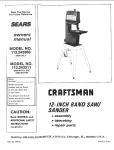
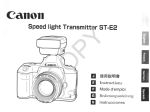
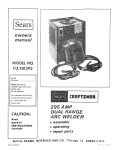
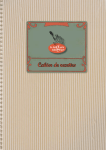
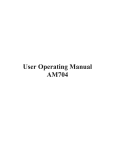
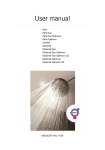
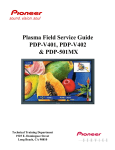
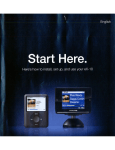

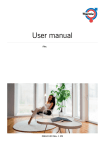
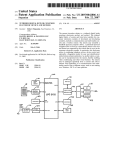
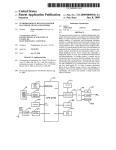
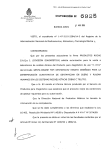
![v .] jCg _ 1l(_ `o,C..NN EinCOR `1_11E1](http://vs1.manualzilla.com/store/data/005961751_1-73960e1521729271050e00b8575619b8-150x150.png)
